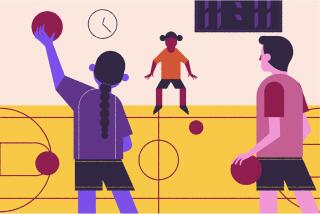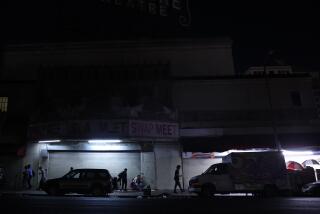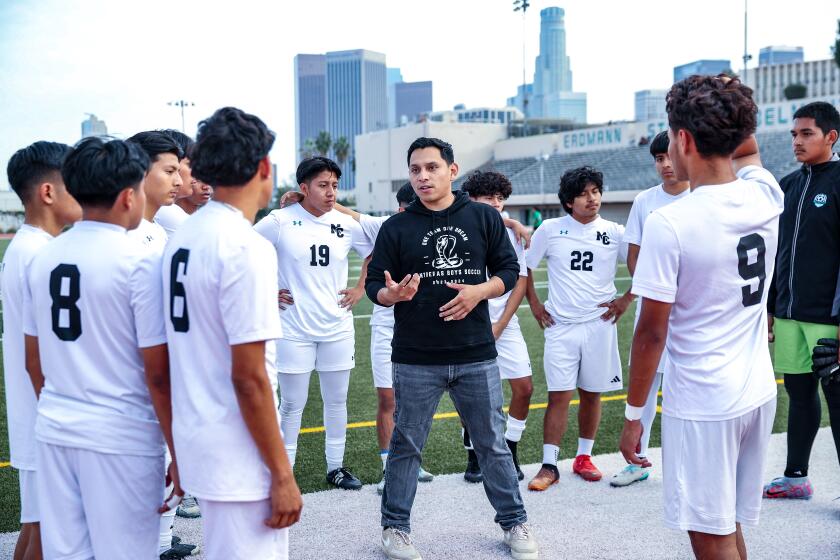BOYLE HEIGHTS : Park’s Sports Take Off Despite Threats
- Share via
The field at Pecan Park is muddy now because the city is planting grass. The basketball pavilion leaks like a faucet when it rains, keeping boys teams from practicing. Children have to be escorted to the bathrooms to ward off the heroin addicts and child molesters who prey on them.
These problems--and the constant threat of gunfire from warring gangs in the neighborhood--are only a few of the obstacles that youths and recreation leaders have to overcome to keep the park’s sports programs going.
Nonetheless, Pecan Park has signed up scores of youngsters for flag football, soccer, basketball and baseball. With the help of a grant from the Amateur Athletic Foundation, park officials have purchased uniforms for team members, hired referees, staged banquets and handed out awards at the end of the season. Young participants pay $10 each for a year of as many sports as they want to join.
“We wanted something for (the youth) to look forward to,” said park supervisor Jose Lopez. “We do offer things for the community.”
Lopez, the only full-time staff member at the park, relies on volunteers from as far away as South-Central to help out with the teams. They recently finished the flag football season, in which 150 boys and 14 girls ages 6 to 16 competed.
The Amateur Athletic Foundation funds sports clubs in Southern California with interest earned from surplus money raised for the 1984 Olympics. More than $24 million in grants have been awarded to youth sports organizations since the AAF was formed in 1985, said spokesman Barry M. Zepel.
The foundation has funded the sports program at Pecan Park--one of 11 sports programs and the only Eastside park that receives foundation funding--since 1990, at about $25,000 per year, Lopez said. The city budgets $1,100 annually for equipment, he said.
Before the foundation stepped in, the park had four teams with about 50 youngsters competing in flag football, said part-time recreation assistant Ruben Rodriguez, who grew up in the neighborhood.
“We would go out to get donations from the stores around here for trophies, equipment, uniforms and then we’d officiate ourselves,” Rodriguez said.
Since 1990, soccer increased from four to eight teams; flag football grew from six to 12 teams; basketball went from five to 12 teams; and baseball went from nine to 19 teams, Zepel said. The number of children involved in sports at Pecan Park jumped from 288 in 1990 to 612 in 1992, he said.
“They always say if it weren’t for the foundation, they wouldn’t have the programs,” said Cathey Tyree, program associate with the Amateur Athletic Foundation.
Located in the middle of the Aliso Village and Pico Gardens housing projects, Pecan Park sometimes comes under siege from several warring gangs there.
Rodriguez and Lopez recalled a flag football game that was disrupted when a bystander apparently high on drugs started shooting at the teams from the sidelines. Once soccer players were forced to lie flat on the field because gang members were shooting nearby.
“We really can’t blame them,” Rodriguez said. “But they want to make sure we still play because our teams make the league.”
Rodriguez and Lopez say they try to encourage parents to continue their enthusiasm and involvement in their children’s sports throughout their lives, not just when they’re in Pee-Wee leagues.
They believe that is a key to reducing the number of children who get involved with gangs.
“I’m surprised with the amount of shooting that we have as many kids still involved,” Lopez said. “A lot of these kids are on the border between being in a gang and not being in a gang. We push them forward to get them on the positive side.”
More to Read
Go beyond the scoreboard
Get the latest on L.A.'s teams in the daily Sports Report newsletter.
You may occasionally receive promotional content from the Los Angeles Times.










